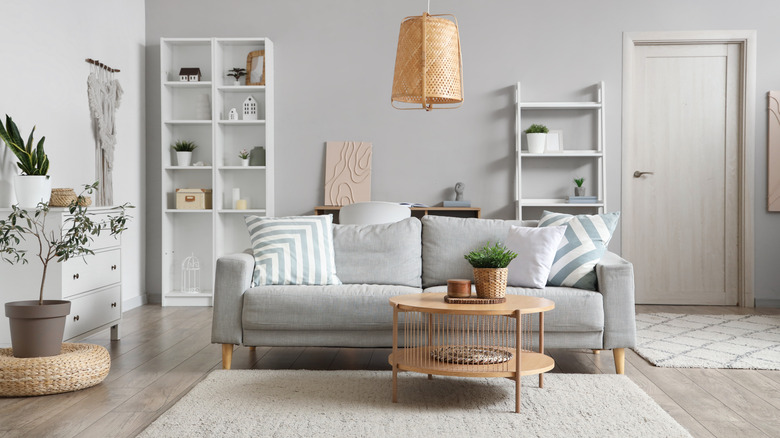Why You Should Leave Open Space On Shelves When Styling Decor
Whether you have stylish open shelving or a massive bookcase you need to fill with vignettes, adding decor to shelving helps make a home feel more curated and intentional. When styled well, these various knick-knacks and collectibles give a peek into the person's personality. You get a glimpse into family photos, travel mementos, the style of art and pottery they like, as well as which aesthetics they subscribe to. For instance, if you see a reclaimed wood bowl, you know they love modern farmhouse. However, when filling up these spaces with trinkets, there is one crucial rule you want to keep in mind: You should leave open space on shelves when styling decor.
The reason for that is it gives the items some breathing room. If you crowd everything around each other, then the space will end up looking cluttered rather than curated. But how much space is enough space? Let's take a closer look at the design rule and figure out how to style your shelves.
Why you should leave open space on shelves when styling decor
It can be tempting to put all of your favorite things on display, especially if you have lots of shelving. It's almost like a curiosity case waiting to happen. However, if you want to design with aesthetics in mind, then you would be better served if you curated and pared down your options. That's because you need negative space to make the display seem curated rather than merely stored. Without that negative space, the shelves will begin looking cluttered and claustrophobic.
To create the best results, use the three-item tip to declutter your shelves. Group items in threes, clustering them across the shelf or unit. That's because an odd number captures the eye more while also creating balance. But in order to cluster things into threes, you need enough space between vignettes for the eye to register their separate groups and not one giant collection. Depending on how big your shelf is, the distance is going to be different. For example, if you have a standard-sized shelf of a few feet wide, try to keep things around a foot apart. But if you have a large floating shelf in your living room that spans a wall, you can keep things 1.5 to 2 feet apart. Use your best judgment for your particular scenario.
How to figure out the spacing
If you tried to create ample negative space around your vignettes but it turned out looking awkward, there is a great trick you can do to help make it flow more cohesively. And that is to display your large items first. Clear all of your shelves, and then choose your standout pieces. These are your larger trinkets, like vases, busts, plants, bulky pottery, or larger picture frames. First put those up, spacing them far apart.
Once you like how they're positioned, add in your smaller knick-knacks and accessories, creating groups of threes with the larger items. You can add varying heights to make the collection seem more dynamic rather than copy-pasted, whether that means putting a candlestick on a stack of books to give it more height, or a bowl on a raised tray. But once you create your clusters, you will see that they have plenty of space between each other naturally, due to this order of styling.


